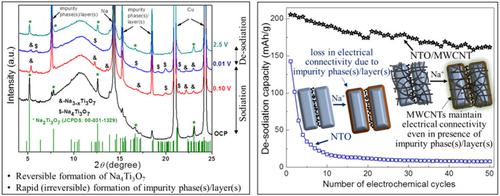当前位置:
X-MOL 学术
›
ChemElectroChem
›
论文详情
Our official English website, www.x-mol.net, welcomes your
feedback! (Note: you will need to create a separate account there.)
Understanding the Cyclic (In)stability and the Effects of Presence of a Stable Conducting Network on the Electrochemical Performances of Na2Ti3O7
ChemElectroChem ( IF 3.5 ) Pub Date : 2018-02-20 , DOI: 10.1002/celc.201701276 Hem Shruti Bhardwaj 1 , Thrinathreddy Ramireddy 1 , Anagha Pradeep 1 , Manoj K. Jangid 1 , Velaga Srihari 2 , Himanshu K. Poswal 2 , Amartya Mukhopadhyay 1
ChemElectroChem ( IF 3.5 ) Pub Date : 2018-02-20 , DOI: 10.1002/celc.201701276 Hem Shruti Bhardwaj 1 , Thrinathreddy Ramireddy 1 , Anagha Pradeep 1 , Manoj K. Jangid 1 , Velaga Srihari 2 , Himanshu K. Poswal 2 , Amartya Mukhopadhyay 1
Affiliation

|
Despite being a promising anode material for the Na‐ion battery system, Na‐titanate (viz., Na2Ti3O7) lacks in terms of cyclic stability; the cause(s) for which are under debate. Against this backdrop, through electrochemical measurements and in situ synchrotron X‐ray diffraction studies, the present work develops insights into the aspects concerning electrochemical reversibility of the fully sodiated phase (i.e., Na4Ti3O7), possible occurrence of irreversible reactions in Na‐ion cells, influences of the same towards cyclic instability, and a strategy towards alleviating this problem. The in situ studies rule out (in)stability/(ir)reversibility of Na4Ti3O7 as being a major cause for the capacity fade; rather they indicate the formation of ‘impurity’ phase(s) due to reaction with the electrolyte. Incorporation of multi‐walled carbon nanotubes (MWCNTs; uniformly ‘wrapping’ the rod‐shaped Na2Ti3O7 particles) significantly improved the cyclic stability (ca. 78 % reversible capacity retention after 50 cycles, as compared to ca. 6 % without MWCNTs) and rate capability (with nearly flat potential plateaus at 5C). The same suppressed the increase in charge‐transfer resistance upon cycling by an order of magnitude and also changed the sodiation reaction from being primarily surface to diffusion controlled. Correlation of the results/analysis indicate that, in the absence of a stable conducting network, loss in electrical connectivity owing to the formation of insulating/passivating (surface) phase(s) is the major cause for capacity fade of Na2Ti3O7.
中文翻译:

了解循环(不)稳定性以及稳定导电网络的存在对Na2Ti3O7电化学性能的影响
尽管是为钠离子电池系统,钠钛酸盐的有前途的阳极材料(即,钠。2的Ti 3 ö 7在循环稳定性方面缺乏); 原因尚在争论中。在此背景下,通过电化学测量和原位同步加速器X射线衍射研究,本工作对完全钠化相(即Na 4 Ti 3 O 7)的电化学可逆性方面有了深入的了解。),Na-离子电池中可能发生不可逆反应,其对循环不稳定性的影响以及缓解此问题的策略。原位研究排除了Na 4 Ti 3 O 7的(不稳定性)/(ir)可逆性是容量衰减的主要原因。相反,它们表明由于与电解质的反应而形成了“杂质”相。掺入多壁碳纳米管(MWCNT;均匀地“包裹”棒状Na 2 Ti 3 O 7)颗粒)显着改善了循环稳定性(50个循环后约78%的可逆容量保持率,而无MWCNT的可逆容量保持率约为6%)和速率容量(5C时几乎稳定的平稳状态)。这同样抑制了循环时电荷转移电阻的增加一个数量级,并且也将碱化反应从最初的表面改变为扩散控制。结果/分析的相关性表明,在没有稳定的导电网络的情况下,由于形成绝缘/钝化(表面)相而导致的电连接性损失是Na 2 Ti 3 O容量衰减的主要原因7。
更新日期:2018-02-20
中文翻译:

了解循环(不)稳定性以及稳定导电网络的存在对Na2Ti3O7电化学性能的影响
尽管是为钠离子电池系统,钠钛酸盐的有前途的阳极材料(即,钠。2的Ti 3 ö 7在循环稳定性方面缺乏); 原因尚在争论中。在此背景下,通过电化学测量和原位同步加速器X射线衍射研究,本工作对完全钠化相(即Na 4 Ti 3 O 7)的电化学可逆性方面有了深入的了解。),Na-离子电池中可能发生不可逆反应,其对循环不稳定性的影响以及缓解此问题的策略。原位研究排除了Na 4 Ti 3 O 7的(不稳定性)/(ir)可逆性是容量衰减的主要原因。相反,它们表明由于与电解质的反应而形成了“杂质”相。掺入多壁碳纳米管(MWCNT;均匀地“包裹”棒状Na 2 Ti 3 O 7)颗粒)显着改善了循环稳定性(50个循环后约78%的可逆容量保持率,而无MWCNT的可逆容量保持率约为6%)和速率容量(5C时几乎稳定的平稳状态)。这同样抑制了循环时电荷转移电阻的增加一个数量级,并且也将碱化反应从最初的表面改变为扩散控制。结果/分析的相关性表明,在没有稳定的导电网络的情况下,由于形成绝缘/钝化(表面)相而导致的电连接性损失是Na 2 Ti 3 O容量衰减的主要原因7。











































 京公网安备 11010802027423号
京公网安备 11010802027423号